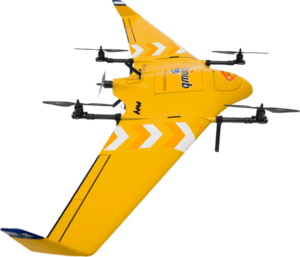
The drone industry continues to evolve, with new hardware offerings appearing at every new trade show. As industry observers look for hard evidence on what to expect next, one clue can be found in these year-end review statistics DRONELIFE received from open source drone development leaders Auterion. (The data source to compile the contributions statistics is the PX4 Github domain (https://github.com/PX4). Contributors were mapped to the respective companies based on their email address. Developers with a non-company email address were added to the “unaffiliated” pool.)
Auterion – a company which helps drone companies put increasingly complex open source elements of drone operation together, so that they can focus on their differentiators – received a $10 million funding round in September of 2018. Run by the originators of the open source PX4 drone operating ecosystem, their growth since then is evident on their website drones page – the list of fixed wing, quads, multicopters, and heavy lift drones, all powered by open source operating systems, keeps growing. (Drones-for-good fixed wing Avy, pictured.) While Auterion is the leading contributor to the PX4 ecosystem, they aren’t the only ones: and that’s meaningful to the drone industry. Continued contributions from universities and research institutions indicate that research projects continue to use and develop the ecosystem. And more diversity in the list from corporate institutions means that the industry can expect to see more open source powered hardware offerings on the market, either this year or next.
The following is taken from a DRONELIFE exclusive peek at Auterion’s PX4 contribution statistics, which they will publish later this week:
2019 has been a great year for the PX4 ecosystem. Since the founding of PX4 in 2011, the software stack has continually evolved and is now the most widely used open-source flight control and autopilot system for autonomous aircraft, with a community of 600+ contributors and over 9,600 users. The PX4 standard has been adopted by hundreds of companies and integrated into an ever-widening range of drone applications. Hosted by the Linux Foundation, any developer or company may participate in PX4 development. Let’s take a look at the community’s accomplishments and contributions in 2019.
2019 Contribution statistics
The community made a total of 7,180 contributions and added a staggering 1.5 million lines of code. Comparing the community participation rankings for 2019 to 2018, we note the following observations:
- In 2019, Auterion made over 50% the 7,180 contributions, compared to 33% in 2018 when it ranked as the single largest contributing entity.
- Auterion is the only contributor with development under all projects in the ecosystem, demonstrating dedication and competence across the entire software stack, as contributions are evaluated based on meritocracy and only the best code is accepted.
- Unaffiliated developers as a group were the top contributors in 2018 and remain as one of the most important and influential contributors in 2019, with top individual contributors like Daniel Agar, Don Gagne, and David Sidrane doing significant contributions to PX4 firmware and QGroundControl.
- After the top contributor Auterion, 3DR, Arrival, Aeronavics, Wingtra, Copter, EPFL, are part of the Top 10 contributing entities, while Yuneec Research, Intel, and ETH Zurich fell off the list.
- PX4 firmware remains as the area where the majority of contributions take place, followed by QGC, MAVSDK, documentation, and MAVLink.
- The growing contributions to MAVSDK compared to the previous year point to the maturation of the industry as companies increasingly focus on integrating innovative new applications into their unmanned systems.
- Globally top-ranking Universities like EPFL Lausanne, MIT, ETH Zurich, and Carnegie Mellon are the largest academic contributors to the PX4 ecosystem, making sure that the latest research makes its way to real-world applications.
Miriam McNabb is the Editor-in-Chief of DRONELIFE and CEO of JobForDrones, a professional drone services marketplace, and a fascinated observer of the emerging drone industry and the regulatory environment for drones. Miriam has penned over 3,000 articles focused on the commercial drone space and is an international speaker and recognized figure in the industry. Miriam has a degree from the University of Chicago and over 20 years of experience in high tech sales and marketing for new technologies.
For drone industry consulting or writing, Email Miriam.
TWITTER:@spaldingbarker
Subscribe to DroneLife here.

